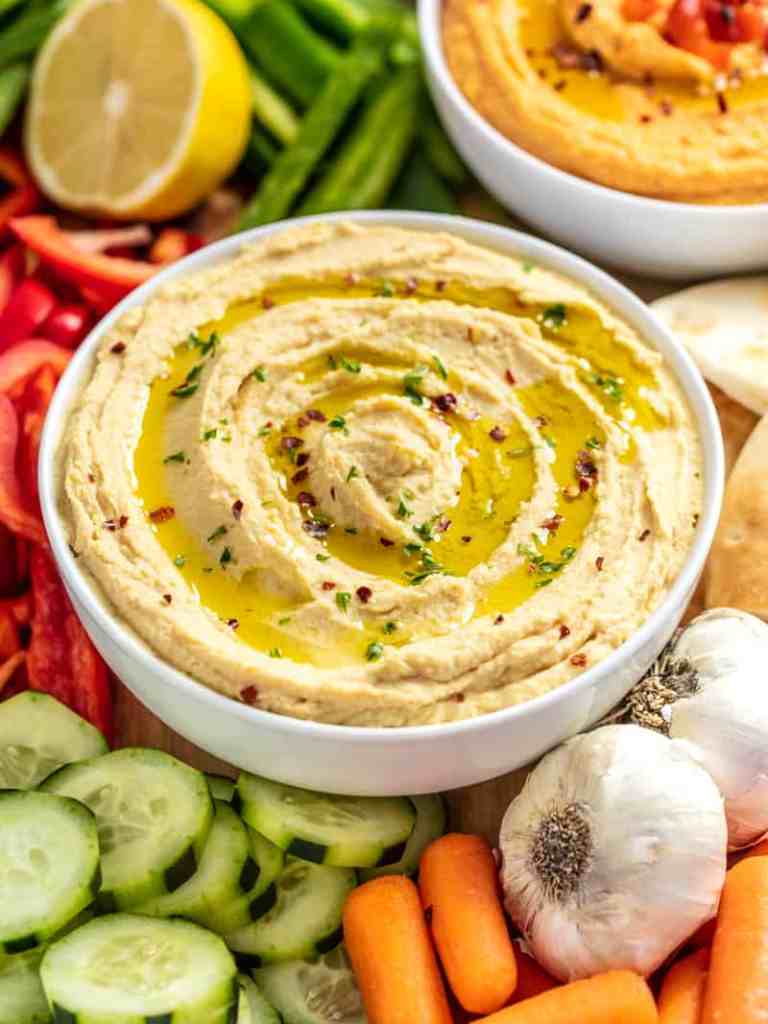The Best Hummus Recipe -Fail-Proof-

Hummus is a Middle Eastern dip, spread, or savory dish made from cooked, mashed chickpeas blended with tahini, lemon juice, and garlic. The standard garnish in the Middle East includes olive oil, a few whole chickpeas, parsley, and paprika. In Middle Eastern cuisine, it is usually eaten as a dip, with pita bread.
Chickpeas, the main ingredient of conventional hummus, have appreciable amounts of dietary fiber, protein, vitamin B6, manganese and other nutrients.
As hummus recipes vary, so does nutritional content, depending primarily on the relative proportions of chickpeas, tahini, and water. Hummus provides roughly 170 calories for 100 grams, and is a good to excellent (more than 10% of the Daily Value) source of dietary fiber, vitamin B6, and several dietary minerals.
Fat content, mostly from tahini and olive oil, is about 14% of the total; other major components are 65% water, 17% total carbohydrates, including a small amount of sugar, and about 10% protein.
Bare chickpeas!
Don’t just open the can, rinse it and then blend it. To avoid being bloated from the first dip and throughout the rest of the aperitif, remove the skin of the chickpeas. It is painful and long, we know, but we assure you: it is bad for good.
A tip? Roll your chickpeas in a tea towel, the skins will come off easily, all you have to do is remove them.
Sesame cream (tahini) essential for a successful hummus
If your hummus doesn’t have that great taste you expected, perhaps you forgot tahini, that sesame cream essential to any good self-respecting hummus.
Spices do you want some here
Even after the 6th pinch of cumin, your hummus has no taste? Turn to fresh and well-preserved spices, it will only be better. And between us, no fuss: if you prefer paprika or raz el hanout, whatever, as long as you like your hummus, indulge yourself with the spices.
A drop here, a drop there
Is your hummus way too compact? No need to pour half the bottle of olive oil to try to make it creamier. If you have soaked and cooked your dry chickpeas, add a little cooking water. Otherwise, tap water will do just as well. And don’t forget the lemon juice: in addition to subtly spicing up your spread, it will make it creamy.
Now that you know all the tips to make your hummus for sure and delight your guests, here is the recipe for homemade hummus . Don’t serve it on its own: serve it with homemade pita breads .

The Best Hummus Recipe -Fail-Proof-
Description
Hummus, that creamy dip that hails from the Middle East, has a reputation as clean, healthy food. It deserves it. All the main ingredients are super foods in their own right. It's got chickpeas, sesame paste (tahini), garlic, and olive oil in most traditional versions
Ingredients
To Garnish
Instructions
-
For a perfectly smooth hummus first, you need to peel the chickpeas.
Fill the bowl with water, Add 400 gr canned chickpeas in a large bowl and rub to take the skin off. it will start to float. When you drain, skins will group on water and it will be much easier to collect.
-
Add peeled chickpeas, 2 cloves of garlic, half of a teaspoon salt, 6 tablespoons of tahini, and 2 tablespoons of extra virgin olive oil to a food processor.
-
Squeeze a lemon juice and run for 7-8 minutes on low-medium speed.
-
While the food processor is working the hummus will get warm. To avoid that add 6 cubes of ice gradually. ıce will help to make a smooth hummus as well.
-
- After a couple of minutes hummus will be okay but not smooth enough. Don’t give up and continue until the hummus is creamy. You can run on high speed at this stage.
-
Taste and adjust the lemon, tahini and salt to your taste. Garlic and olive oil always need time to settle. If you have 2-3 hours before eating the taste will be better.
-
When the hummus is ready put on serving table and make a little crater with the back of a spoon.
-
Sprinkle ground sumac, cumin and parsley leaves. Last but not least pour 2-3 tablespoons of extra virgin olive oil.
-
Enjoy your creamy, tasty, simple hummus with your lavash or chips as your spoon!



